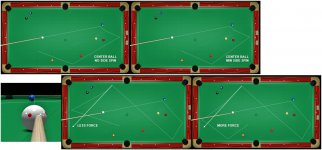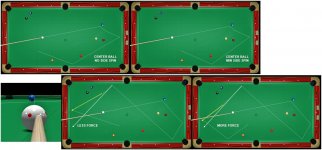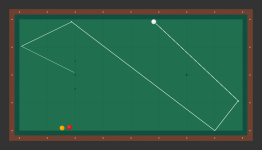In fact the "follow" shots do show curve. Hold a straight edge up to the screen and you can see it.
Yes, the first shots have full smooth rolling by the time they get to the object ball. That's why they curve. The shots played at high speed do not have time to curve much even though they are played with some follow.
Slippery cloth will make the curves wider. The table in Pat's diagrams has brand new cloth. That is shown by the extent of the curves for the softer shots. Follow takes time to develop and it requires more time to develop with low friction.
The deflection angle for the hard hit and less hard hit high shots look the same. Both look like an almost 90 degree stun angle. So you are saying a ball hit even with "less hard" high action will still follow the tangent line with almost no forward curve if the cloth is slippery enough. hmmm.
You are also saying the small amount of forward roll developed by a center ball hit will produce a lot of forward curve if the cloth is older (or dirtier).
That would make the cloth condition a bigger factor than where you hit the cue ball. I don't think I have ever played on cloth that slippery or that dirty but I will take your word for it all. To me the images are exactly backwards from the type hit so that makes it all about the condition of the cloth. Forgive me for my skepticism but I don't think I can produce a stun shot deflection angle no matter how hard I hit the ball at that distance if I hit high on the cue ball.
Of course the terms Hard and less hard are ambiguous. You are still tops in authority in my book. I will have to experiment more with the slippery cloth idea. I haven't experienced these extremes but am limited to a small community of tables.


